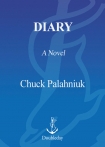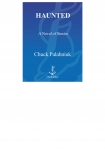Diary, Chuck Palahniuk [spicy books to read .TXT] 📗

- Author: Chuck Palahniuk
Book online «Diary, Chuck Palahniuk [spicy books to read .TXT] 📗». Author Chuck Palahniuk
He stuck another weed in his mouth and chewed, saying, “So what makes Misty Kleinman a maniac?”
Her fantasy houses and cobblestone streets. Her seagulls circling the oyster boats as they came back from the shoals she'd never seen. The window boxes overflowing with snapdragons and zinnias. No way in fucking hell was she going to paint that crap.
“Maura Kincaid,” Peter says, “didn't pick up a paintbrush until she was forty-one years old.” He started taking paintbrushes out of the pale wood box, twisting the ends sharp. He said, “Maura got hitched to a good old Waytansea Island carpenter, and they had a couple kids.” He took out her tubes of paint, setting them next to the brushes there on the blanket.
“It wasn't until her husband died,” Peter said. “Then Maura got sick, really sick, with consumption or something. Back then, being forty-one made you an old lady.”
It wasn't until one of her kids died, he said, that Maura Kincaid ever painted a picture. He said, “Maybe people have to really suffer before they can risk doing what they love.”
You told Misty all this.
You said how Michelangelo was a manic-depressive who portrayed himself as a flayed martyr in his painting. Henri Matisse gave up being a lawyer because of appendicitis. Robert Schumann only began composing after his right hand became paralyzed and ended his career as a concert pianist.
You were digging in your pocket while you said this. You were fishing something out.
You talked about Nietzsche and his tertiary syphilis. Mozart and his uremia. Paul Klee and the scleroderma that shrank his joints and muscles to death. Frida Kahlo and the spina bifida that covered her legs with bleeding sores. Lord Byron and his clubfoot. The Brontë sisters and their tuberculosis. Mark Rothko and his suicide. Flannery O'Connor and her lupus. Inspiration needs disease, injury, madness.
“According to Thomas Mann,” Peter said, “‘Great artists are great invalids.' ”
And there on the blanket, you set something. There, surrounded by tubes of paint and paintbrushes, was a big rhinestone brooch. Big around as a silver dollar, the brooch was clear glass gems, tiny polished mirrors in a pinwheel of yellow and orange, all of them chipped and cloudy. There on the plaid blanket, it seemed to explode the sunlight into sparks. The metal was dull gray, gripping the rhinestones with tiny sharp teeth.
Peter said, “Are you hearing any of this?”
And Misty picked up the brooch. The sparkle reflected straight into her eyes, and she was blinded, dazzled. Disconnected from everything here, the sun and weeds.
“It's for you,” Peter said, “for inspiration.”
Misty, her reflection showed shattered a dozen times in every rhinestone. A thousand pieces of her face.
To the sparkling colors in her hand, Misty said, “So tell me.” She said, “How did Maura Kincaid's husband die?”
And Peter, his teeth green, he spit green into the tall weeds around them. The black cross on his face. He licked his green lips with his green tongue, and Peter said, “Murder.” Peter said, “They murdered him.”
And Misty started to paint.
July 6
JUST FOR THE RECORD, the cruddy old library with its wallpaper peeling at every seam and dead flies inside all the milk-glass lights hanging from the ceiling, everything you can remember is still here. If you can remember it. The same shabby world globe, yellowed to the color of soup. The continents carved into places like Prussia and the Belgian Congo. They still have the framed sign that says “Anyone Caught Defacing Library Books Will Be Prosecuted.”
Old Mrs. Terrymore, the librarian, she wears the same tweed suits, except now she has a lapel button as big as her face that says “Find Yourself in a New Future with Owens Landing Financial Services!”
What you don't understand, you can make mean anything.
People all over the island are wearing this same kind of button or T-shirt, selling some advertising message. They get a little prize or cash award if they're seen wearing it. Turning their bodies into billboards. Wearing baseball caps with 1-800 telephone numbers.
Misty's here with Tabbi, looking for books about horses and insects her teacher wants her to read before Tabbi starts seventh grade this fall.
No computers. No connections to the Internet or database terminals means no summer people. No lattes allowed. No videotapes or DVDs to check out. Nothing permitted above a whisper. Tabbi's off in the kids' section, and your wife's in her own personal coma: the art book section.
What they teach you in art school is that famous old masters like Rembrandt and Caravaggio and van Eyck, they just traced. They drew the way Tabbi's teacher won't let her. Hans Holbein, Diego Velázquez, they sat in a velvet tent in the murky dark and sketched the outside world that shined in through a small lens. Or bounced off a curved mirror. Or like a pinhole camera, just projected into their tiny dark room through a little hole. Projecting the outside world onto the screen of their canvas. Canaletto, Gainsborough, Vermeer, they stayed there in the dark for hours or days, tracing the building or naked model in the bright sunlight outside. Sometimes they even painted the colors straight over the projected colors, matching the shine of a fabric as it fell in projected folds. Painting an exact portrait in a single afternoon.
Just for the record, camera obscura is Latin for “dark chamber.”
Where the assembly line meets the masterpiece. A camera using paint instead of silver oxide. Canvas instead of film.
They spend all morning here, and at some point Tabbi comes to stand next to her mother. Tabbi's holding a book open in her hands and says, “Mom?” Her nose still on the page, she tells Misty, “Did you know it takes a fire of at least sixteen-hundred degrees lasting seven hours to consume the





Comments (0)